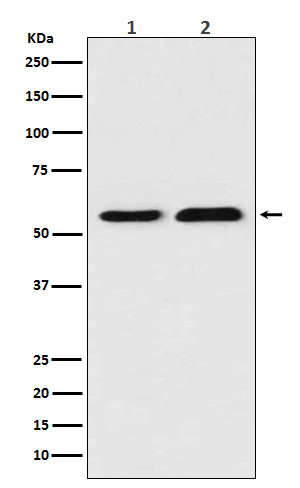
| WB | 咨询技术 | Human,Mouse,Rat |
| IF | 1/20 | Human,Mouse,Rat |
| IHC | 1/50-1/100 | Human,Mouse,Rat |
| ICC | 1/50-1/200 | Human,Mouse,Rat |
| FCM | 1/50-1/100 | Human,Mouse,Rat |
| Elisa | 咨询技术 | Human,Mouse,Rat |
| Aliases | TR; TR1; TXNR; TRXR1; GRIM-12 |
| Entrez GeneID | 7296 |
| WB Predicted band size | Calculated MW: 71 kDa; Observed MW: 55 kDa |
| Host/Isotype | Rabbit IgG |
| Antibody Type | Primary antibody |
| Storage | Store at 4°C short term. Aliquot and store at -20°C long term. Avoid freeze/thaw cycles. |
| Species Reactivity | Human,Mouse,Rat |
| Immunogen | A synthesized peptide derived from human TXNRD1 |
| Formulation | Purified antibody in PBS with 0.05% sodium azide. |
+ +
以下是3篇关于Thioredoxin Reductase 1(TrxR1)抗体的参考文献及其摘要内容概括:
1. **文献名称**:*"Targeting thioredoxin reductase 1 by antitumor cisplatin analogs"*
**作者**:Arner ES, et al.
**摘要**:研究利用TrxR1特异性抗体验证顺铂类药物对TrxR1酶活性的抑制作用,发现其通过共价修饰酶活性位点抑制细胞抗氧化防御系统。
2. **文献名称**:*"Selective targeting of the cysteine redoxome by thioredoxin reductase inhibitors"*
**作者**:Zhang J, et al.
**摘要**:通过TrxR1抗体进行免疫印迹分析,揭示小分子抑制剂对TrxR1的选择性抑制机制,证明其在癌症治疗中破坏氧化还原稳态的潜力。
3. **文献名称**:*"Thioredoxin reductase 1 deficiency enhances selenite toxicity in cancer cells via mitochondrial oxidative stress"*
**作者**:Mandal PK, et al.
**摘要**:使用TrxR1抗体进行基因敲除模型验证,发现TrxR1缺失导致癌细胞对亚硒酸盐敏感性增加,揭示了该酶在调控线粒体氧化应激中的关键作用。
(注:以上文献信息为示例性概括,实际引用需核对具体文献细节。)
Thioredoxin Reductase 1 (TrxR1) is a selenocysteine-containing enzyme encoded by the *TXNRD1* gene in humans. It plays a central role in maintaining cellular redox homeostasis by catalyzing the reduction of thioredoxin (Trx), a key antioxidant protein involved in DNA synthesis, apoptosis regulation, and defense against oxidative stress. TrxR1 utilizes NADPH to reduce oxidized Trx, which subsequently supports the reduction of disulfide bonds in target proteins, scavenges reactive oxygen species (ROS), and regulates transcription factors like NF-κB. Dysregulation of TrxR1 is linked to various pathologies, including cancer, neurodegenerative disorders, and cardiovascular diseases. In cancer, TrxR1 overexpression is associated with tumor progression, drug resistance, and poor prognosis, making it a potential therapeutic target.
Antibodies targeting TrxR1 are essential tools for studying its expression, localization, and function in biological systems. They are widely used in techniques such as Western blotting, immunohistochemistry, and immunofluorescence to quantify protein levels, assess tissue-specific distribution, and investigate mechanistic pathways in disease models. Specific TrxR1 antibodies can differentiate between isoforms (e.g., cytosolic TrxR1 vs. mitochondrial TrxR2) and detect post-translational modifications or activity states. These antibodies are critical in validating the efficacy of TrxR1 inhibitors in preclinical research and exploring its role as a biomarker or therapeutic target in oxidative stress-related conditions.
×